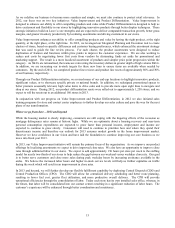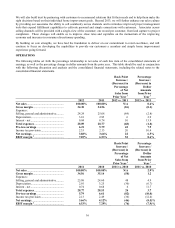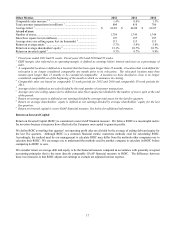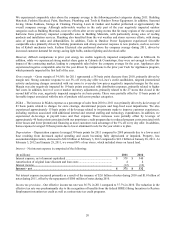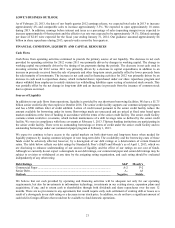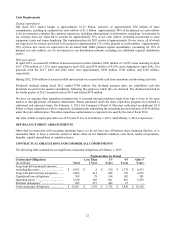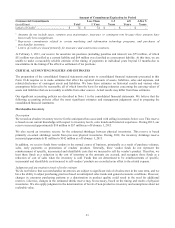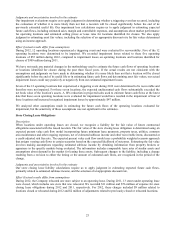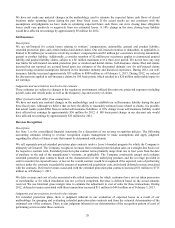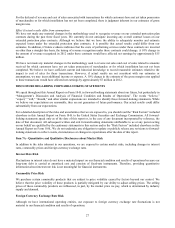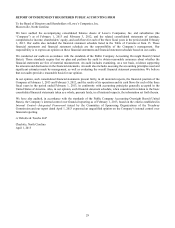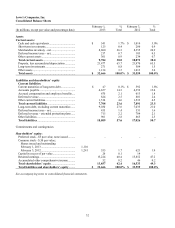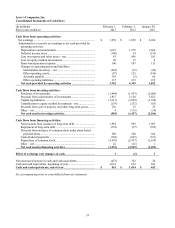Lowe's 2012 Annual Report Download - page 39
Download and view the complete annual report
Please find page 39 of the 2012 Lowe's annual report below. You can navigate through the pages in the report by either clicking on the pages listed below, or by using the keyword search tool below to find specific information within the annual report.25
Judgments and uncertainties involved in the estimate
Our impairment evaluations require us to apply judgment in determining whether a triggering event has occurred, including
the evaluation of whether it is more likely than not that a location will be closed significantly before the end of its
previously estimated useful life. Our impairment loss calculations require us to apply judgment in estimating expected
future cash flows, including estimated sales, margin and controllable expenses, and assumptions about market performance
for operating locations and estimated selling prices or lease rates for locations identified for closure. We also apply
judgment in estimating asset fair values, including the selection of an appropriate discount rate for fair values determined
using an income approach.
Effect if actual results differ from assumptions
During 2012, 12 operating locations experienced a triggering event and were evaluated for recoverability. Five of the 12
operating locations were determined to be impaired. We recorded impairment losses related to these five operating
locations of $55 million during 2012, compared to impairment losses on operating locations and locations identified for
closure of $309 million during 2011.
We have not made any material changes in the methodology used to estimate the future cash flows of operating locations
or locations identified for closure during the past three fiscal years. If the actual results are not consistent with the
assumptions and judgments we have made in determining whether it is more likely than not that a location will be closed
significantly before the end of its useful life or in estimating future cash flows and determining asset fair values, our actual
impairment losses could vary positively or negatively from our estimated impairment losses.
Seven of the 12 operating locations that experienced a triggering event during 2012 were determined to be recoverable and
therefore were not impaired. For these seven locations, the expected undiscounted cash flows substantially exceeded the
net book value of the location’s assets. A 10% reduction in projected sales used to estimate future cash flows at the latest
date that these seven operating locations were evaluated for impairment would have resulted in the impairment of four of
these locations and increased recognized impairment losses by approximately $47 million.
We analyzed other assumptions made in estimating the future cash flows of the operating locations evaluated for
impairment, but the sensitivity of those assumptions was not significant to the estimates.
Store Closing Lease Obligations
Description
When locations under operating leases are closed, we recognize a liability for the fair value of future contractual
obligations associated with the leased location. The fair value of the store closing lease obligation is determined using an
expected present value cash flow model incorporating future minimum lease payments, property taxes, utilities, common
area maintenance and other ongoing expenses, net of estimated sublease income and other recoverable items, discounted at
a credit-adjusted risk free rate. The expected present value cash flow model uses a probability weighted scenario approach
that assigns varying cash flows to certain scenarios based on the expected likelihood of outcomes. Estimating the fair value
involves making assumptions regarding estimated sublease income by obtaining information from property brokers or
appraisers in the specific markets being evaluated. The information includes comparable lease rates of similar assets and
assumptions about demand in the market for leasing these assets. Subsequent changes to the liability, including a change
resulting from a revision to either the timing or the amount of estimated cash flows, are recognized in the period of the
change.
Judgments and uncertainties involved in the estimate
Our store closing lease liability calculations require us to apply judgment in estimating expected future cash flows,
primarily related to estimated sublease income, and the selection of an appropriate discount rate.
Effect if actual results differ from assumptions
During 2012, the Company relocated one store subject to an operating lease. During 2011, 13 stores under operating lease
were closed, which includes one store that was relocated. We recorded $11 million and $76 million of expense for store
closing lease obligations during 2012 and 2011, respectively. For 2012, these charges included $9 million related to
locations closed or relocated during 2012 and $2 million of adjustments related to previously closed or relocated locations.


